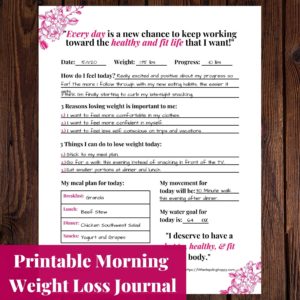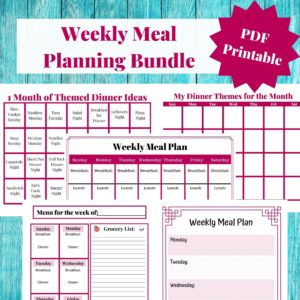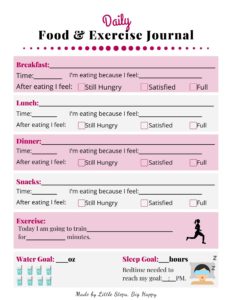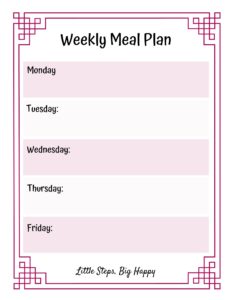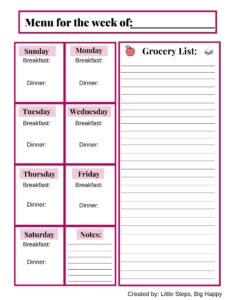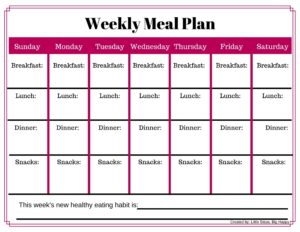When it comes to losing weight, one of the first things you need to know is how to keep a food journal. A good food journal is the backbone of any successful diet.
Keeping a food journal has been one of the best healthy habits that I have ever started. It’s helped me finally lose the baby weight and get into the best shape of my life.
I make a joke with my husband that if anything, I’m just getting better with age and how lucky he is 😂.
I’m mostly kidding around, but I am in better shape than I was when we got married, despite having 3 kids, and I attribute a huge portion of that to being really consistent with my food journal.
In this post, I’m going to talk about how to keep a food journal so you can see some real progress with your weight loss.
Disclosure: This post may contain affiliate links which I’m happy to promote. All thoughts and opinions are my own. Much love & thank you for your support. 😊 To learn more about my policy, click here.
Contents
What is a Food Journal?
Before I get started on how to keep a food journal, let’s go over what a food journal actually is. A food journal refers to any sort of note-taking, planning, or tracking of what you eat.
Some people also call it a diet journal, weight loss journal, food tracker, or something similar to that. Sometimes a food journal might be combined with a fitness journal or planner too.
When you use a food journal, it doesn’t mean you have to stick to a specific diet or follow some sort of program.
In fact, I’m a big believer in keeping diets simple and easy to follow. You can learn about my approach to eating healthy in this post 8 Secrets to a Successful Diet.
In a food journal, you’re basically just writing down what you ate, if your diet working, and why or why not. Having a way to track your diet and assess if it’s working might sound simple, but it has a huge impact on your weight loss journey.
[convertkit form=980679]
Food Journal Example
Here is an example of a simple food journal:

Benefits of Keeping a Food Journal
Keeping a food journal is one of the easiest things you can do to help with weight loss. There are so many benefits to keeping a food journal, but it’s often an activity that a lot of women ignore.
They feel like it’s a “hassle” or a waste of time. It seems like such a small thing that they often feel like it’s not worth the effort.
They want to focus more on the “harder” or “more important” aspects of weight loss. Well, let me tell you why it’s a big mistake to cruise past this super important part of losing weight.
Weight loss
I will say for a fact that keeping a food journal made a big difference in helping with my weight loss. But you don’t just have to take my word for it.
According to Harvard Health Publishing, in one weight loss study of nearly 1,700 participants, “…those who kept daily food records lost twice as much weight as those who kept no records.”
Let that sink in for a minute. The group who kept a daily food journal lost twice as much weight as the group who didn’t!
The only regret I have about keeping a food journal is that I didn’t start doing it earlier. It can make a big difference when it comes to your weight loss.
Learn what foods work for your body
When you keep a food journal it helps you create a record of the foods that actually work for your body. If you’ve had a killer week with your weight loss, you probably want to recreate those results.
Well, if you can’t remember what you actually ate that week, then you’re going to be stuck playing the guessing game. A good food journal gives you a record of the foods that your body processes well.
Despite what a lot of diets try to claim, not everyone’s body responds to foods the same way. Some people do well with certain diets, while others struggle and have adverse reactions.
You need to know how to keep a food journal so that when you’re bouncing around trying different meal plans and recipes, you know which ones are working for you.
Learn what foods DON’T work for your body
Just like keeping a food journal helps you know which foods work for your body, it also creates a good record of the foods that DON’T work for your body. As I said, everyone’s body responds to foods in different ways.
If a certain type of food makes you gain weight, bloat, or retain water, then you probably want to limit or avoid that food while you’re losing weight. But if you never keep a food journal, then you will probably have a hard time pinpointing the foods that are making your weight loss look like a roller coaster ride.
Keeping a food journal is how I learned that my body doesn’t process flour well. I don’t have celiac disease or any gluten issues, but my body tends to immediately store flour as fat and I’m guaranteed to start putting weight on if I include too much of it in my diet.
Also, I learned that I don’t do well on the Keto diet either. I need good healthy carbs to keep my energy levels up and to keep my diet sustainable.
If I hadn’t kept a good record of my food, I would probably still be bouncing around trying to find the “magic diet” that was going to work for me.
As you learn how to keep a food journal, you will be able to keep track of the foods that your body doesn’t respond well to and start to limit how often you eat them.
Detecting food intolerances
Another great benefit of keeping a food journal is helping you detect food intolerances. By writing down exactly what you eat and how you feel, you can identify problem foods in your diet.
According to Everly, food intolerances can cause symptoms such as:
- Headaches
- Migraines
- Bloating
- Indigestion
- Stomach pain
- Gastrointestinal distress
The faster you identify the foods you’re sensitive to, the faster you can cut them out of your diet and start feeling better.
Portion control
Another benefit of keeping a food journal is learning appropriate portion sizes. Most of us eat more than our bodies need.
Especially when we’re hungry, our eyes are often bigger than our stomachs. And unfortunately, most restaurants encourage this tendency.
They offer huge portions and drive-throughs are always eager to “super-size” your order.
Even at home, it can be really easy to serve yourself more than you need without realizing it.
When you keep a food journal, it forces you to really pay attention to how much you’re actually eating. When you have to write it down you pay more attention than you normally would.
Before keeping a food journal I used to think I only ate 2-3 slices of pizza whenever we got delivery. Turns out, I would eat 2-3 slices of pizza, plus the leftover crusts from 2 of my children… and then probably end up snacking on 1 last piece later in the night.
When all was said and done, I was a lot closer to 5 pieces than the original 2 or 3 pieces I thought I ate.
Tracking nutrition
Keeping a food journal also makes it a lot easier to track the nutritional value of what you’re eating. I can fully admit that before I started taking my weight loss seriously, I didn’t think twice about the “nutritional quality” of my food.
If I was hungry I ate what tasted good and moved on with my life.
According to Harvard:
“…many of the foods that help prevent disease also seem to help with weight control-foods like whole grains, vegetables, fruits, and nuts. And many of the foods that increase disease risk-chief among them, refined grains and sugary drinks-are also factors in weight gain.”
Now that doesn’t mean we can’t ever have Cookies & Ice Cream night with the kids, but to lose weight and live an overall healthy life, the nutritional value of our food matters.
All of that gets a whole lot easier to plan and track when you’re keeping a food journal.
Recognize eating habits and patterns
The last reason you need to learn how to keep a food journal is that it helps you recognize your eating habits and patterns. A food journal will help you become more aware of how you eat and where you need to start making changes for weight loss.
So often we get caught up in mindless eating. We snag a quick bite of our kids leftover lunch here, we grab a handful of chips there, etc.
We don’t even realize just how often we are eating and what spurs us to fall back into our unhealthy eating habits.
Starting to recognize your eating habits and triggers can make a huge difference when you’re losing weight. Especially if mindless snacking or emotional eating are things you struggle with.
Who is Food Journaling Good For?
Food journaling is good for anyone who wants to improve their diet. Here’s a quick list of who would benefit from journaling.
- If you’re trying to lose weight.
- You want to eat a healthier diet.
- You’re trying to create better eating habits.
- When you’re trying to identify food intolerances or sensitivities.
- When you’re trying to improve your nutrition.
- If you’re trying to stick to a specific diet.
[convertkit form=980679]
How to Keep a Food Journal for Effective Weight Loss
Keeping a food journal is actually pretty easy. It’s made up of these two steps: tracking and review. With a little practice, it will become an easy habit to add to your day.
Let’s dive into how to actually do each step.
How to Keep a Food Journal Step 1: Track what you’re currently eating
The very first step in keeping a food journal is to track what you’re eating. That means you write down the good, the bad, and the ugly!
That means you include what you ate for breakfast, lunch, and dinner. And the snacks that you had between meals too.
The whole point of the food journal is to get a fully accurate picture of your diet and observe the effects it has on your body. The more data you put in, the better.
How to Keep a Food Journal Step 2: Review your food journal weekly
Once you learn how to keep a food journal, you need to make sure that you actually take the time to look back at the data. All that information is only good if you actually do something with it.
Take time at least once a week to review what you’ve written down. Pay attention to any patterns that you notice. Make note of foods that you enjoyed that helped you lose weight.
You also need to keep track of foods that your body didn’t respond well to. You will use the information from the previous week to help you as you plan out your meals throughout the next week.
The process I like to use is called Keep, Start, Stop
Keep, Start, Stop
Keep, Start, Stop is when you look back over your food journal from the previous week and you review what you want to keep doing, what you want to start doing, and what you want to stop doing.
These are some of the questions I use:
- Keep: What worked this week? What do I want to keep doing?
- Start: What is something I am ready to start doing next week?
- Stop: What didn’t work this week? What do I want to stop doing?
The order of these steps is important too. Always start with the positive. What did you do well this week?
Then you layer in your next steps forward. What do you want to start doing?
Last you tackle the things you’re ready to let go of. What can you stop doing?
When you focus on what you did well first, you’re going to feel a lot more motivated and confident making your plan going forward.
[convertkit form=980679]
What Should I Write in a Food Journal?
What you include in your food journal is based mostly on your goal. If you’re looking to dive deep into your eating habits, you want to focus mainly on the triggers and environment you encounter when you eat.
If you’re focused more on nutrition, then you will want to focus more on the types of food you’re eating and the times and quantities.
Below I’ve listed several pieces of information you can include in your food journal. Read through and pick and choose which you think would help you the most.
Don’t feel like you need to include them all. I started with just what I was eating when I first began keeping a food journal and it helped with my weight loss.
Once I got more used to journaling my food, I started including more information. I will say though, the more information you include in your food journal, the better you will understand your overall eating patterns and habits.
What you ate
The first thing you need to write down is what kind of food you ate. For this, I keep it pretty simple. I write down what I eat, and if necessary where it came from.
I like to write down whether I made it or whether I got it at a restaurant because the ingredients can be a lot different. The chili I cook at home has way less salt and add-ins than whatever I might get at a restaurant.
This is also an important thing to note if you’re paying attention to possible food intolerances or sensitivities.
How much you ate
As you write down what you’re eating try your best to write down accurate portions. You don’t have to stress too much about whether you ate ½ cup of rice or ¾ cup, but you want to do your best to be accurate.
The more accurately you write down what you eat, the more the information will help you make better eating decisions moving forward.
Time of day
The next thing to track is the time of day. This is important for a few reasons:
- Whether or not you’re eating for true physical hunger.
- Whether what you’re eating is filling enough.
- Identify any “habit eating.”
Oftentimes we can get urges to eat that are more from emotional hunger than true physical hunger. Maybe we’re stressed, tired, or even bored.
This can often show up an hour or so after eating a regular meal. When you don’t note the time, it becomes a lot easier to give in to those cravings.
Writing down the time you eat in your food journal can also help you identify foods that aren’t filling enough for a full meal. For example, I recently had some delicious Strawberry and Chia Seed Overnight Oats for breakfast one week.
As good as it tasted, I noticed that I became hungry about 1-2 hours after eating it every morning. This lets me know I probably shouldn’t plan it for breakfast again and will probably use it as a snack going forward.
Sometimes we can get very used to eating at a certain time of day. If you typically eat breakfast at 8:00 am, lunch at 12:00 pm, and dinner at 6:00 pm, your body is going to get used to eating at that time of day.
And your brain will remind you to eat, even if you’re not actually hungry.
Overeating when we’re not physically hungry is one of the big factors that can lead to weight gain. Tracking the time you eat can help identify those times of the days that our cravings kick in without us even realizing it.
Where you eat
Keeping track of where you eat in your food journal can be very useful in identifying eating patterns and behaviors. For example, I noticed that I tend to get very snacky when I hang out and play games on the computer with my husband in the evenings.
Or that I will eat more at a restaurant out with friends than I do at home with just my family. This information can help you identify eating patterns or habits that you can work on to see better results with your weight loss.
Who you’re with
Like I mentioned before, sometimes our eating habits change based on who we’re around. If you have a group of friends who loves to eat out or who constantly offer you food, you may be more likely to overeat when you’re around those people.
My mother constantly tells me how her boyfriend is a “food-pusher” and how much harder it is to stick to her diet when he’s around.
Understanding how you eat around other people is another step in understanding your eating patterns and behaviors.
What you’re doing when you eat
The next thing you can track in your food journal is what you were doing when you were eating. For example were you driving, working, sitting at the computer, in front of the TV, etc.?
Depending on what you’re doing, you may be more likely to end up mindlessly eating instead of paying attention to when you’re body is full or satiated.
I know for a fact that I tend to eat more when I’m reading a book or watching TV than I do when I’m driving or just sitting talking to friends. When I’m distracted while eating, it’s hard to pay attention to my portion sizes or recognize when I should stop eating versus clearing my plate.
Mood
The last thing I would suggest you track while keeping a food journal is how you’re feeling when you eat. Our moods can have a huge impact on what and how much we eat.
Emotional eating is a big factor for overeating in a lot of women. (Myself included!)
Until I started keeping a food journal, I never realized how often I would decide to make a batch of pancakes at 9:30 pm because I had a stressful day.
Writing down how you’re feeling when you eat can help you really tune into whether you’re eating due to emotions or physical hunger.
Related Posts:
- 5 Surprising Benefits of Journaling for Weight Loss
- Overeating vs. Satisfied: How to Tell if You’re Eating Too Much
[convertkit form=980679]
Tips for Keeping a Food Journal
Here are some tips I have found to be helpful in keeping my own food journal. I know in the beginning it can seem like a hassle or extra work.
Especially when you’re kids are asking you to help them with something for the 50th time in a row and you’re rushing out the door.
But trust me, the effort of figuring this out is more than worth the initial adjustment period. Once you get used to doing it, it will only take a few minutes a day.
Write everything down
The number one rule of keeping a food journal is you have to write down everything. And I do mean, EVERYTHING.
Did you snag your son’s leftover peanut butter and jelly crusts walking through the dining room? Write it down.
If you took a few bites of your toddler’s macaroni and cheese in an effort to finally get him to try a new food, write it down.
Did you sneak off into your closet to eat some Reeses’ Peanut Butter cups without any of your kids watching? Write it down.
The more consistently and honestly you write down what you eat each day, the more your food journal is going to help you and the more results you’ll see with your weight loss.
Do it right away, don’t wait until the end of the day
The best way to make sure you’re as accurate as possible with your food journal is to write everything down right away. Odds are pretty good that you’ll forget what you had later in the day.
If you’re anything like me, you’re probably permanently sleep-deprived and have so many things you’re trying to keep track of at any given moment you often forget why you walked into a room.
You’re much better off writing down your food as soon as you can so you don’t forget about it in the chaos that is daily mom life.
Be specific
Be as specific as you can when you write down the information in your food journal. Don’t just write down soup.
How much soup? What kind? Where was it from? Did you finish it all off? Did you have second helpings? Did you eat some crackers or a slice of bread with it?
All of that information is going to affect your body and your weight so it needs to be included in your food journal.
Estimate amounts when you need to
My next tip on how to keep a food journal is to estimate amounts when you need to. Portion size is important, especially when trying to lose weight, but I don’t want you to get so worried about it that it stops you from actually writing it down in your journal.
If you’re at a restaurant and you order some soup write down whether you got a bowl of soup or a cup of soup. And if you only ate half of it, write that down too.
But if you don’t know whether you ate 1 cup of soup or 1 ½ cups of soup, that’s ok. Do the best that you can and keep moving forward.
Be honest
If you want to see any success with your eating habits and your weight loss, then you have to be honest when you write in your food journal.
If you leave out what you ate because it was just a few bites or because you don’t want it to count, you’re only hurting yourself.
A food journal is meant to be an accurate representation of your current diet, eating habits, and patterns. If you aren’t being completely honest in your food journal you’re probably going to miss important information about how you eat.
If I had left out all the little bites, snacks, and nibbles, I never would have realized that I snacked so much at my desk or during the afternoons.
It would have been so easy to say “a little bit doesn’t hurt.” But when you say that enough times throughout the day, a little bit becomes a lot.
That was definitely the case for me and had I not been honest when writing down my food, I never would have realized how many times I used that to justify eating when I wasn’t actually hungry.
Keep a food journal for a week to get a good snapshot of your eating habits
Write down what you eat in your food journal for at least a week to get an accurate snapshot of your eating habits. Many of us eat very differently on the weekends versus the weekdays.
With a more relaxed schedule and often more access to food, your eating behavior on Saturday and Sunday might look totally different than the rest of the week.
You need to track your food for a full week to get a good idea of your current eating habits.
I would honestly suggest at least 2-3 weeks if you’re tracking your food for weight loss, but 7 days is the bare minimum.
Include drinks
My last tip on how to keep a food journal is to make sure you include what you’re drinking. Like everything else that goes into your body, what you drink affects your health and your weight.
Sodas, juice, and alcohol are full of calories that can impact your weight and diet. How much of them you drink is important information in getting a good overall picture of your eating habits.
I can personally attest that when I have a few drinks, I’m waaay more likely to snack the evening away with my lowered inhibitions.
While you’re tracking your drinks, make sure to also track how much water you drink. Drinking enough water and making sure you’re properly hydrated can help you lose weight and fight hunger cravings.
Writing down everything you drink can help you see where and how you can make other improvements in your diet.
[convertkit form=980679]
The Best Ways to Keep a Food Journal
The very best way to keep a food journal is whatever way is easiest for you. I have used apps, simple pen and paper, digital journals, and more.
I have found apps to be the easiest for when I’m on the go, but it really depends on what works best for you. Being accurate and consistent is the most important part, so feel free to explore the different methods and find the one that suits you best.
Tools for Keeping a Food Journal
Now that you know how to keep a food journal, here are some great resources to actually get started! These are all either free or very inexpensive.
Printable Worksheets
Daily Food & Exercise Journal
With this worksheet, you can write down what you eat, what time, how you’re feeling, and whether you were still hungry, satisfied, or full after your meal. There’s also room to plan your exercise for the day and track your water and sleep. You can sign up to get your copy here.
Grab your copy here!
Simple Weekly Meal Plan
With this simple Weekly Meal Plan worksheet, you can plan out your dinners for the week. If you’re new to meal planning, this worksheet is a great place to start. You can get it here.
Grab your copy here!
Weekly Meal Planning Worksheet w/ Grocery List
This worksheet has room for you to plan out your breakfasts and dinners for the whole week and write your grocery list as you go along. You can get it here.
Grab your copy here!
Healthy Habits Daily Journal
This worksheet has room for you to track your meals all day and fill in whether you ate until full, satisfied, or still hungry. It also has room for you to track your water and sleep. You can get your copy here.
Grab your copy here!
Weekly Meal Plan & Goals
This worksheet has space for you to plan and track your breakfast, lunch, dinner, and snacks for the entire week. It also has space for you to write out the healthy eating habit you are working on so you can keep it top of mind throughout the day. You can get it here.
Grab your copy here!
Food Journal Apps
If you prefer the convenience of doing everything on your phone, here are some of my favorite food journal apps.
Ate – The Mindful Food Journal
This is definitely my favorite food journaling app. It’s free and makes it super easy. All you do is take a picture of your food before you eat it and tap whether it was on plan or not.
It will automatically track the time you are eating. It’s really simple to go back and manually add in food if you need to add in something from earlier in the day.
You also have the option of putting in where you ate, how you felt, where you were at, and a few other questions. This is really helpful for pinpointing habits and behavior patterns in your eating.
You can get it here.
Rise Up: Eating Disorder Help
This app is geared to those with an eating disorder, but it still has a lot of useful tools even if you don’t feel like that applies to you. My favorite feature is that it allows you to track your food without counting calories.
It also gives you the option to put in where, when, and with who you are eating. Plus, motivational quotes, affirmations, and the ability to put in reminders.
You can find it here for Android and here for Apple.

See How You Eat
See How You Eat is a simple app for balanced eating. No calorie counting or restrictive dieting. It focuses on a simple 80/20 approach to a balanced diet.
The app allows you to visually see the food you’re eating which helps to create a more balanced approach. You can get it here.
[convertkit form=980679]
Conclusion on How to Keep a Food Journal for Effective Weight Loss
So there you have everything you need to know on how to keep a food journal for weight loss. If you follow those steps, you will set yourself up for success with your diet and eating habits.
Have you tried keeping a food journal before? How did it work out? Let us know in the comments or email me at Candice@littlestepsbighappy.com. Follow me on Pinterest for more weight loss tips and advice.
Looking for more weight loss tips?
- How to Set Health and Fitness Goals for Weight Loss
- 7 Quick Weight Loss Tips for Busy Moms
- 10 Simple Tips to Help You Lose Weight on a Budget
- 7 Simple Tips to Avoid Holiday Weight Gain This Year
- How to Take Body Measurements for Weight Loss: Step-by-Step Tutorial
- 9 of the Best Morning Habits for Weight Loss
- 10 Habits You Need to Break to Lose Weight for Good
- 21 Small Diet Changes to Lose Weight for Good
- 5 New Year’s Resolutions to Lose Weight This Year
- 5 Ways Coaching for Weight Loss Speeds Up Your Progress
- How to Lose Weight Without Starving: Smart Tips to Try Today!
- 7 Tips to Manage Food Cravings and Sustain Your Weight Loss
Pin this for Later!!👇👇

You might also like…




I’m a busy mom of 3 turned Health and Fitness Coach and Self Defense Instructor. I help inspire other moms to reach their health, fitness, and weight loss goals. You can usually find me chasing my kiddos around, training Brazilian Jiu-Jitsu, or sneaking away to read romance novels. About Me



